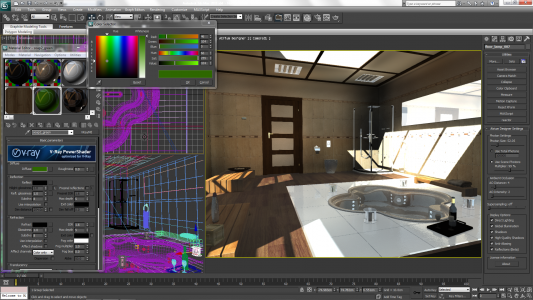As 3D modeling software has matured, most of the emphasis on visualization quality has gone to the final rendering. But new technology from a German university spin-off may change all that.
[Editor’s note: A video from Siggraph 2012 produced by Intel about Lumatix Atrium Designer 2012 appears at the end of this article.]
A university spin-off from Germany is now selling the first in what it expects to be a series of plug-ins for 3D modeling software that will radically change the notion of what can be expected from preview rendering.
Lumatix Atrium Designer 2012 provides real-time preview rendering integrated as an Autodesk 3ds Max viewport. Its developers say the product is capable of calculating digital lighting situations with greater realism than stand-alone 3ds Max at speeds 500,000 times faster than comparable solutions. Tasks that would require several hours to render complete in just a few milliseconds with high quality results on standard computers.

Working in an Autodesk 3ds Max viewport, Atrium Designer 2012 controls indirect lighting and its effect on materials, light sources, and geometry. Post-processing can be carried out in milliseconds, enabling client decisions and subsequent changes to be made immediately. Lumatix says animation and still-image rendering can be previewed genuinely in real time to speed projects by up to 80%.
Lumatix GmbH began in 2009 as a spin-off of the teaching chair for computer graphics at the University of Erlangen-Nuremberg, Germany. The company was founded a year later in Erlangen. We spoke recently with Christian Heckl, Lumatix Managing Director and CTO, who said the startup is “realizing our vision of calculating dynamic global lighting in genuine real time – fully interactively and to a very high quality.”
“We are not another final renderer—there are lots of them,” says Heckl. Lumatix is all about the preview mode, where the designer spends most of the time on a project. “There is big business value for artists to be able to share immediately.” Heckl claims Lumatix Atrium Designer can resolve a view in 60 millisecond which would otherwise take a half-hour. The speed difference gives the designer new options to test materials, lighting effects, and to receive feedback from a client. “What we do now in a team viewing session an artist can do with clients. Push the button and it is done.”

Heckl stresses that the technology behind Atrium Designer is an approximation; there is still need for a final rendering. “You still need the final renderer to get the high-gloss results.” Global illumination was the focus of the initial research that led to Atrium Core. “The real-time global illumination is the breakthrough. Real-time for V-Ray is from 3 to 5 minutes, real-time for us is 20 milliseconds.”
A very zippy demo
During a demo, it became obvious that testing various lighting solutions in real time is an immediate benefit of using Atrium Designer. Shadows are a big issue for many product and architectural renderings, but if reviewing shadows requires waiting for a final-quality rendering, a lot of hurry-up-and-wait time is added to a project. “This is a handy tool for fine-tuning lighting,” says Heckl. “A user could do this interactively with a client.”

Atrium Designer is based on technology called Atrium Core. It uses a hybrid approach to processing using both CPU and GPU cores as available. The goal for the first commercial release was to have it run well on standard hardware. The demonstration for this article used an Intel four-core CPU running an Nvidia GeForce card—certainly nobody’s definition of a high-end workstation. “The faster the computer, the faster the product,” notes Heckl. “We tried to make it efficient and use all hardware resources. The hardware in most workstations is sufficient. We want a low entry point.”
Heckl is quick to point out that Atrium Designer benefits from recent advances in computer graphics hardware. “The software solution today would not have been possible three years ago; the hardware renderers today are better. We work closely with Intel and AMD/ATI to make sure our algorithms and their technologies are in line.”
Heckl says the technology in Atrium Core is similar to what is available in final-frame rendering software, the difference being the focus on preview rendering. “Given enough time we can do what Mental Ray or V-Ray do,” says Heckl. “Those final renderers ray trace, while Atrium Core rasterizes. The lighting is based on photon mapping optimized for preview work.”
A free trial download of Lumatix Atrium Designer 2012 for 3ds Max is available at the Lumatix web site.
A video of Lumatix Atrium Designer 2012 featuring Managing Director Christian Heckl at Siggraph 2011 in Vancouver, produced by Intel. (Source: Intel via YouTube)





